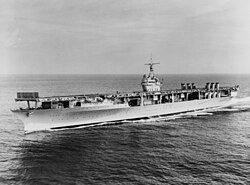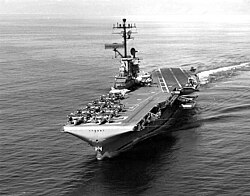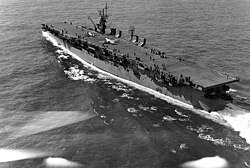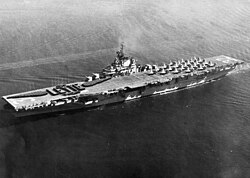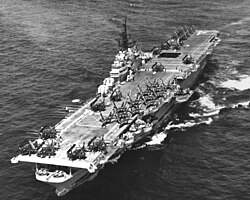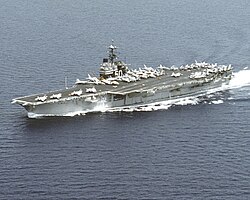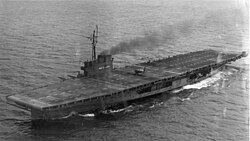Top Qs
Timeline
Chat
Perspective
List of aircraft carriers of the United States Navy
Super Carriers From Wikipedia, the free encyclopedia
Remove ads
Aircraft carriers are warships that act as airbases for carrier-based aircraft. In the United States Navy, these ships are designated with hull classification symbols such as CV (Aircraft Carrier), CVA (Attack Aircraft Carrier), CVB (Large Aircraft Carrier), CVL (Light Aircraft Carrier), CVE (Escort Aircraft Carrier), CVS (Antisubmarine Aircraft Carrier) and CVN (Aircraft Carrier (Nuclear Propulsion)). Beginning with the Forrestal class, (CV-59 to present) all carriers commissioned into service are classified as supercarriers.
Remove ads
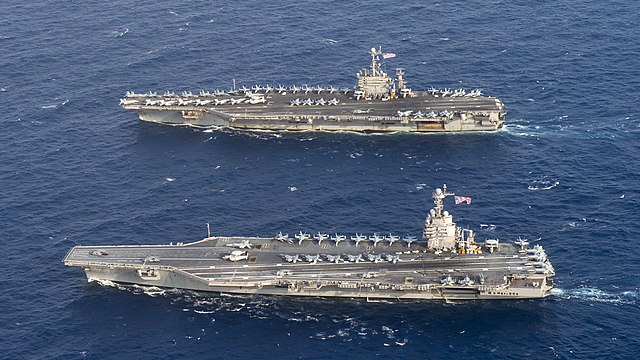


The U.S. Navy has also used escort aircraft carriers (CVE, previously AVG and ACV) and airship aircraft carriers (ZRS). In addition, various amphibious warfare ships (LHA, LHD, LPH, and to a lesser degree LPD and LSD classes) can operate as carriers; two of these were converted to mine countermeasures support ships (MCS), one of which carried minesweeping helicopters. All of these classes of ships have their own lists and so are not included here.
Remove ads
Historical overview
Summarize
Perspective
The first aircraft carrier commissioned into the U.S. Navy was USS Langley (CV-1) on 20 March 1922. The Langley was a converted Proteus-class collier, originally commissioned as USS Jupiter (AC-3).[1] It was soon followed by the other pre-World War II classes: the Lexington class; USS Ranger, the first U.S. purpose-built carrier; theYorktown class, and USS Wasp.[2]
As World War II loomed, two more classes of carriers were commissioned under President Franklin Roosevelt: the Essex class, which is informally divided into regular bow and extended bow sub-classes, and the Independence-class ships, which are classified as light aircraft carriers.[3] Between these two classes, 35 ships were completed.[citation needed] The Navy also purchased two training vessels, USS Wolverine and USS Sable, which were given the unclassified miscellaneous (IX) hull designation.[4]
The Midway class and the Saipan class were built later in World War II, but entered service too late to serve in the war. The Midway class would serve during the entire Cold War.[5]
At the start of the Cold War, the first supercarriers, the United States class, were canceled due to the Truman administration's policy of shrinking the United States Navy and in particular, the Navy's air assets. The policy was revised after a public outcry and Congressional hearings sparked by the Revolt of the Admirals.[citation needed]
Later in the Cold War, supercarrier construction began with the Forrestal class,[6] followed by the Kitty Hawk class; Enterprise (CVN-65), the first nuclear-powered carrier; and John F. Kennedy (CV-67), the last conventionally powered carrier. These were followed by the Nimitz class and the modern-day post-cold war Gerald R. Ford-class nuclear supercarriers, the only two classes of supercarriers that are currently in active-duty service.[7] With the ten-ship Nimitz class complete by 2009, October 2013 saw the launch of Gerald R. Ford, lead ship of the planned ten-ship Gerald R. Ford class. This was followed by the launch of John F. Kennedy (CVN-79) in October 2019, while construction is underway on Enterprise (CVN-80) and Doris Miller (CVN-81).[12]
Remove ads
List
Summarize
Perspective
- Keys
- out of service
- in active service
- cancelled before completion
- under construction
- on order
Remove ads
Training ships
Summarize
Perspective
During World War II, the United States Navy purchased two Great Lakes side-wheel paddle steamers and converted them into freshwater aircraft carrier training ships. Both vessels were designated with the hull classification symbol IX and lacked hangar decks, elevators or armaments. The role of these ships was for the training of pilots for carrier take-offs and landings in a safe area where the carriers would not be at risk of attack by hostile forces.[86] Together the Sable and Wolverine trained 17,820 pilots in 116,000 carrier landings. Of these, 51,000 landings were on Sable.[87]
Aircraft carrier museums
See also
- Escort carrier
- List of amphibious warfare ships
- List of aircraft carriers
- List of aircraft carriers by configuration
- List of aircraft carriers in service
- List of aircraft carriers of World War II
- List of current ships of the United States Navy
- List of escort carriers of the United States Navy
- List of ships of World War II
- List of sunken aircraft carriers
- List of United States Navy ships
- List of United States Navy losses in World War II § Aircraft carriers (CV/CVL) - abbreviated list
- List of US Navy ships sunk or damaged in action during World War II § Aircraft carriers (CV) - detailed list
- Naval Inactive Ship Maintenance Facility
- Sea Control Ship
- Seaplane tender/seaplane carrier
- Timeline for aircraft carrier service
- Timeline of aircraft carriers of the United States Navy
Remove ads
References
External links
Wikiwand - on
Seamless Wikipedia browsing. On steroids.
Remove ads





